Greco-Roman Museum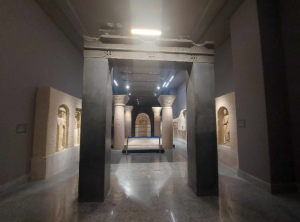
The Greco-Roman Museum
Established in 1891, the museum initially consisted of 11 halls, which later expanded to 25. It was reopened in November 2023. This museum is distinguished by its collection of Greek, Roman, and Pharaonic artifacts.
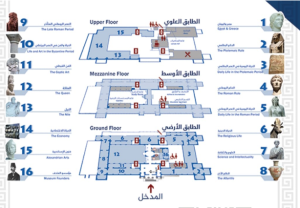
Important Pieces in the Museum
First Floor
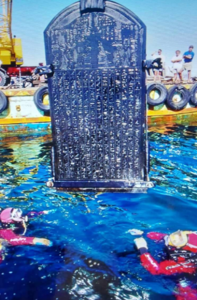
 The two black basalt stelae of Naukratis and Heraklion date back to the reign of King Nectanebo I (362-380 BC).
The two black basalt stelae of Naukratis and Heraklion date back to the reign of King Nectanebo I (362-380 BC).
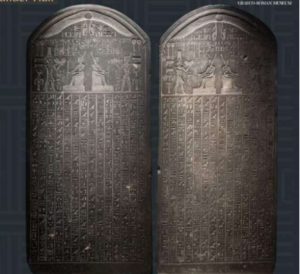
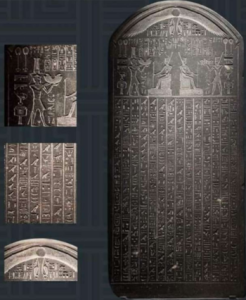 One of them was discovered in the city of Heraklion (Abu Qir) in 2006 (among the Greek artifacts). The other was discovered in 1899 in Naukratis in the Delta (the first Greek settlement in Egypt). They are royal decrees allocating a percentage of the fees from commercial ships passing through the port of Heraklion to the temple of the goddess Neith in the city of Sais (Sa el-Hajar).
One of them was discovered in the city of Heraklion (Abu Qir) in 2006 (among the Greek artifacts). The other was discovered in 1899 in Naukratis in the Delta (the first Greek settlement in Egypt). They are royal decrees allocating a percentage of the fees from commercial ships passing through the port of Heraklion to the temple of the goddess Neith in the city of Sais (Sa el-Hajar).
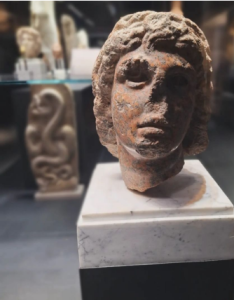 A red granite head of Alexander the Great, depicted as a handsome young man looking upwards as if seeking wisdom from the gods
A red granite head of Alexander the Great, depicted as a handsome young man looking upwards as if seeking wisdom from the gods
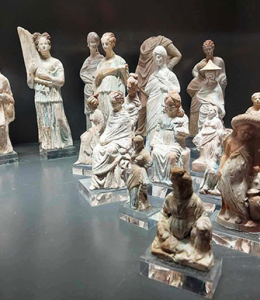 A collection of colorful terracotta figurines depicting women was discovered in the Ibrahimiya area and is displayed in the Daily Life Hall. These figurines showcase the styles and elegance of women’s clothing
A collection of colorful terracotta figurines depicting women was discovered in the Ibrahimiya area and is displayed in the Daily Life Hall. These figurines showcase the styles and elegance of women’s clothing
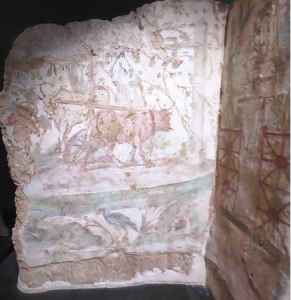 A colored wall painting depicting the oldest water wheel in history. We can appreciate the vibrant colors, the Taurus pulling the wheel, and the image of a hoopoe bird at the bottom.
A colored wall painting depicting the oldest water wheel in history. We can appreciate the vibrant colors, the Taurus pulling the wheel, and the image of a hoopoe bird at the bottom.
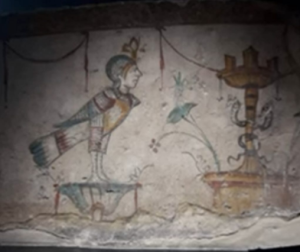 A wall painting depicting the alba (soul) of the deceased in the form of a bird, dating back to the 1st century AD.
A wall painting depicting the alba (soul) of the deceased in the form of a bird, dating back to the 1st century AD.
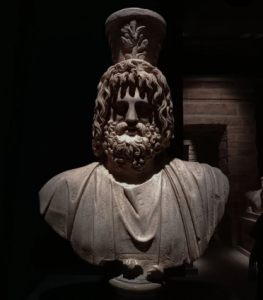 A white marble bust of the god Serapis in human form, featuring a thick beard and five strands of hair on the forehead symbolizing the five districts of Alexandria, with a clathos on his head.
A white marble bust of the god Serapis in human form, featuring a thick beard and five strands of hair on the forehead symbolizing the five districts of Alexandria, with a clathos on his head.
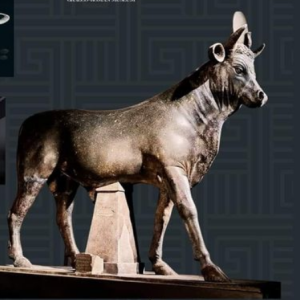 A diorite statue of the Apis bull was discovered in 1895. It has a solar disk and a sacred snake on its head, and an inscription dating back to the reign of Hadrian (117 AD) is found on its belly.
A diorite statue of the Apis bull was discovered in 1895. It has a solar disk and a sacred snake on its head, and an inscription dating back to the reign of Hadrian (117 AD) is found on its belly.
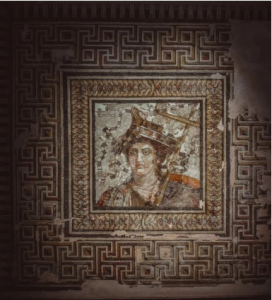 A mosaic portrait of Queen Berenice II, wife of Ptolemy III, was discovered in Tamay, Dakahlia Governorate, in 1923. Berenice is depicted wearing a ship-shaped crown and holding a scepter like the rudder of a ship.
A mosaic portrait of Queen Berenice II, wife of Ptolemy III, was discovered in Tamay, Dakahlia Governorate, in 1923. Berenice is depicted wearing a ship-shaped crown and holding a scepter like the rudder of a ship.

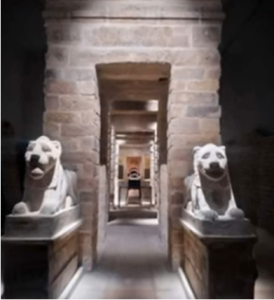
The Temple of the crocodile god Sobek was discovered in Fayoum and was built by a man named Agathodorus, an Alexandrian citizen dating back to the reign of Ptolemy VII. At the entrance, there are two statues of lions, and inside in the Holi of holies, a mummified crocodile statue.
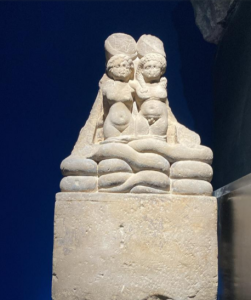
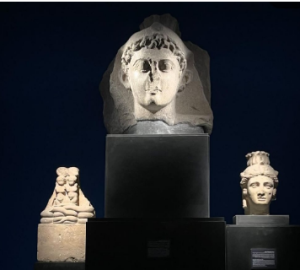 On the right, a limestone statue of Queen Cleopatra with delicate features, adorned with a cobra on her head as a symbol of her rule over Egypt. In the middle, Mark Antony, and to the left, their twin children, Alexander Helios and Cleopatra Selene. The twins, representing the sun and moon, wear royal crowns and embrace each other. A snake, symbolizing protection, coils around their feet.
On the right, a limestone statue of Queen Cleopatra with delicate features, adorned with a cobra on her head as a symbol of her rule over Egypt. In the middle, Mark Antony, and to the left, their twin children, Alexander Helios and Cleopatra Selene. The twins, representing the sun and moon, wear royal crowns and embrace each other. A snake, symbolizing protection, coils around their feet.
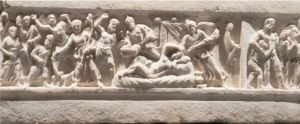
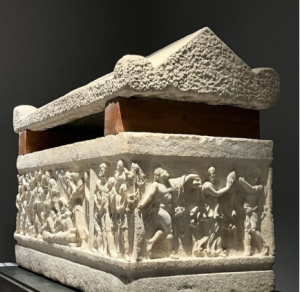 A marble sarcophagus was discovered in Max in Alexandria and dates back to the mid-2nd century AD. It depicts the myth of Ariadne. We see Ariadne asleep on a bed, with Dionysus and his followers, both men and women, preparing for a celebration. Other scenes depict Hercules’ victory in battle, as well as scenes from the era of winemaking.
A marble sarcophagus was discovered in Max in Alexandria and dates back to the mid-2nd century AD. It depicts the myth of Ariadne. We see Ariadne asleep on a bed, with Dionysus and his followers, both men and women, preparing for a celebration. Other scenes depict Hercules’ victory in battle, as well as scenes from the era of winemaking.
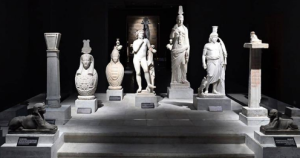
The Temple of the Black Head was discovered in 1936. It was built by a man named Isidorus who lived in Alexandria. He had a foot illness and vowed that if he recovered, he would build a temple to the goddess Isis. True to his word, he constructed the temple. Within the temple, we find Alabaster statues of the goddess Isis, adorned with a robe and a double crown flanked by the horns of Hathor and two feathers. Hermunubis stands before Isis, holding a feather. We also see Osiris in the form of Osiris Kanop, wearing a double crown. Additionally, there’s a statue of Harpocrates depicted as a naked child leaning on a cloak. Two sphinxes adorn the temple, and a pillar bears an inscription of the vow, topped by a human foot.
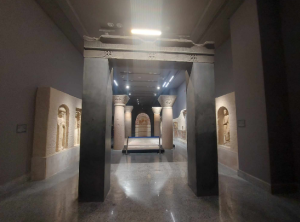 Imitating the form of a church, we see four red granite columns topped with basket capitals, a Byzantine influence. The floor is made of mosaic dating back to the Byzantine era, depicting the myth of Andromeda and Perseus.
Imitating the form of a church, we see four red granite columns topped with basket capitals, a Byzantine influence. The floor is made of mosaic dating back to the Byzantine era, depicting the myth of Andromeda and Perseus.
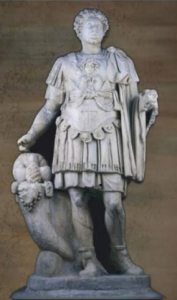 A marble statue of Marcus Aurelius, in military attire. On his chest is the head of Medusa, used to inspire fear, followed by a griffin and then the shape of a cross. He rests his hand on a cornucopia
A marble statue of Marcus Aurelius, in military attire. On his chest is the head of Medusa, used to inspire fear, followed by a griffin and then the shape of a cross. He rests his hand on a cornucopia
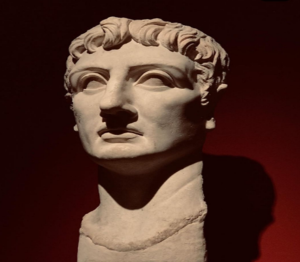 Alabaster head of Emperor Augustus was discovered in Tell Atrib, Banha.
Alabaster head of Emperor Augustus was discovered in Tell Atrib, Banha.
 A funerary stela dating back to the 1st and 2nd centuries BC, made of limestone. We see a young student standing in the pose of a scholar within an Egyptian architectural façade. In his left hand, he holds a cluster of grapes, a symbol of the god Dionysus. He wears a Greek chiton (tunic), and his right hand is inside his robe, resting on his chest.
A funerary stela dating back to the 1st and 2nd centuries BC, made of limestone. We see a young student standing in the pose of a scholar within an Egyptian architectural façade. In his left hand, he holds a cluster of grapes, a symbol of the god Dionysus. He wears a Greek chiton (tunic), and his right hand is inside his robe, resting on his chest.
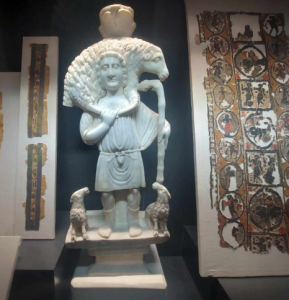 A statue of the Good Shepherd carrying a lost sheep back to the fold. This is a symbol of Jesus Christ in the Holy Bible
A statue of the Good Shepherd carrying a lost sheep back to the fold. This is a symbol of Jesus Christ in the Holy Bible
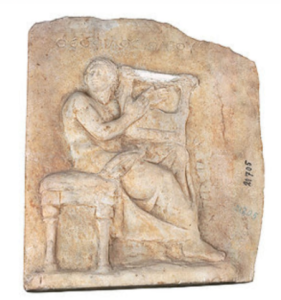 A marble tomb depicting the deceased as a nearly naked, muscular blind man seated on a chair, playing the kithara. The deceased’s name, Theophilus, is inscribed on the tombstone in Greek.
A marble tomb depicting the deceased as a nearly naked, muscular blind man seated on a chair, playing the kithara. The deceased’s name, Theophilus, is inscribed on the tombstone in Greek.
Second floor in the museum
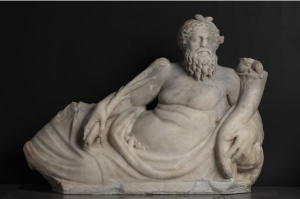 The god Nilus, the god of the Nile River, is depicted as an old man reclining, holding wheat stalks in his right hand and a cornucopia in his left.
The god Nilus, the god of the Nile River, is depicted as an old man reclining, holding wheat stalks in his right hand and a cornucopia in his left.
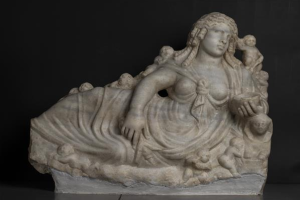 A statue of the goddess Euthyne, wife of Nilus, made of Alabaster, was discovered in the Hamra area of Sidi Bishr. She is depicted standing on a sphinx and holding a sacred water vessel. Her hair is styled in the form of wheat ears, symbolizing fertility and prosperity.
A statue of the goddess Euthyne, wife of Nilus, made of Alabaster, was discovered in the Hamra area of Sidi Bishr. She is depicted standing on a sphinx and holding a sacred water vessel. Her hair is styled in the form of wheat ears, symbolizing fertility and prosperity.

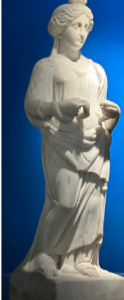 A statue of the goddess Hygieia, the goddess of health in Greek mythology. She is typically depicted as a young woman standing upright with her arms slightly extended, holding a snake, one of her attributes, and a sacrificial bowl (patera).
A statue of the goddess Hygieia, the goddess of health in Greek mythology. She is typically depicted as a young woman standing upright with her arms slightly extended, holding a snake, one of her attributes, and a sacrificial bowl (patera).
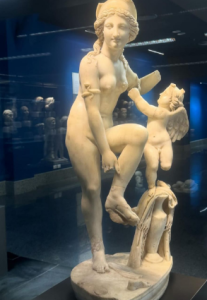 A marble statue of the goddess Aphrodite dating back to the 2nd century AD. Aphrodite stands nude, with a crown on her head and a snake-shaped object in her right hand. She leans on her right leg and raises her left foot, as if she is taking off her sandal. Her son, Eros, stands on a vessel covered by Aphrodite’s garment, looking at her.
A marble statue of the goddess Aphrodite dating back to the 2nd century AD. Aphrodite stands nude, with a crown on her head and a snake-shaped object in her right hand. She leans on her right leg and raises her left foot, as if she is taking off her sandal. Her son, Eros, stands on a vessel covered by Aphrodite’s garment, looking at her.
 A statue of Harpocrates in the form of a child with his finger on his lips, symbolizing the silence that was one of the attributes of the god Horus during the Greco-Roman period.
A statue of Harpocrates in the form of a child with his finger on his lips, symbolizing the silence that was one of the attributes of the god Horus during the Greco-Roman period.
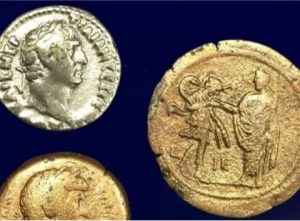 A bronze coin depicting the emperor Hadrian on the obverse and a woman representing Alexandria on the reverse, with a snake behind her, kissing the emperor’s hand.
A bronze coin depicting the emperor Hadrian on the obverse and a woman representing Alexandria on the reverse, with a snake behind her, kissing the emperor’s hand.
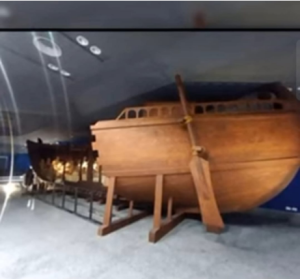
 A wooden vessel model dating back to the 2nd century AD. Inside it is a collection of amphoras, which are two-handled jars. The large number of amphoras indicates a flourishing trade during that period.
A wooden vessel model dating back to the 2nd century AD. Inside it is a collection of amphoras, which are two-handled jars. The large number of amphoras indicates a flourishing trade during that period.
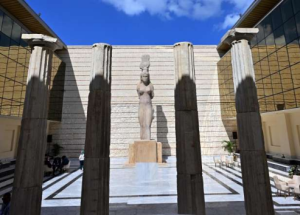
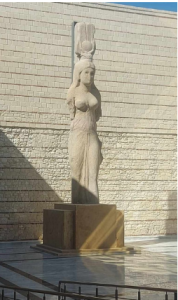 A Massive Statue of a Ptolemaic Queen In the form of the goddess Isis-Faria, dating back to the Ptolemaic period, it was found in front of Qaitbay Castle among the submerged artifacts discovered at the site and is now displayed in the museum’s special courtyard. She is depicted wearing the attire of Hathor and with the sun disk between the horns of a cow on her head.
A Massive Statue of a Ptolemaic Queen In the form of the goddess Isis-Faria, dating back to the Ptolemaic period, it was found in front of Qaitbay Castle among the submerged artifacts discovered at the site and is now displayed in the museum’s special courtyard. She is depicted wearing the attire of Hathor and with the sun disk between the horns of a cow on her head.





